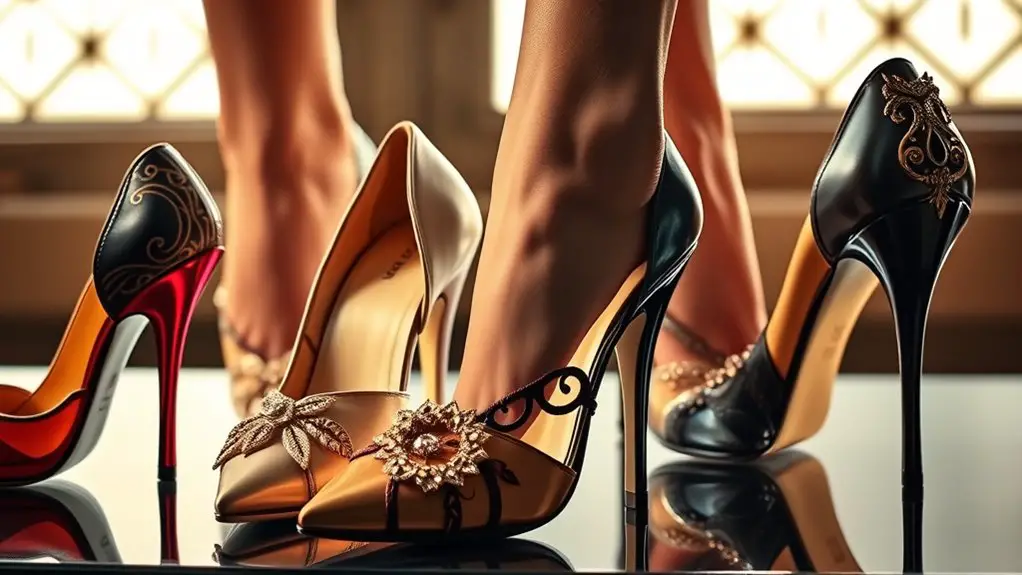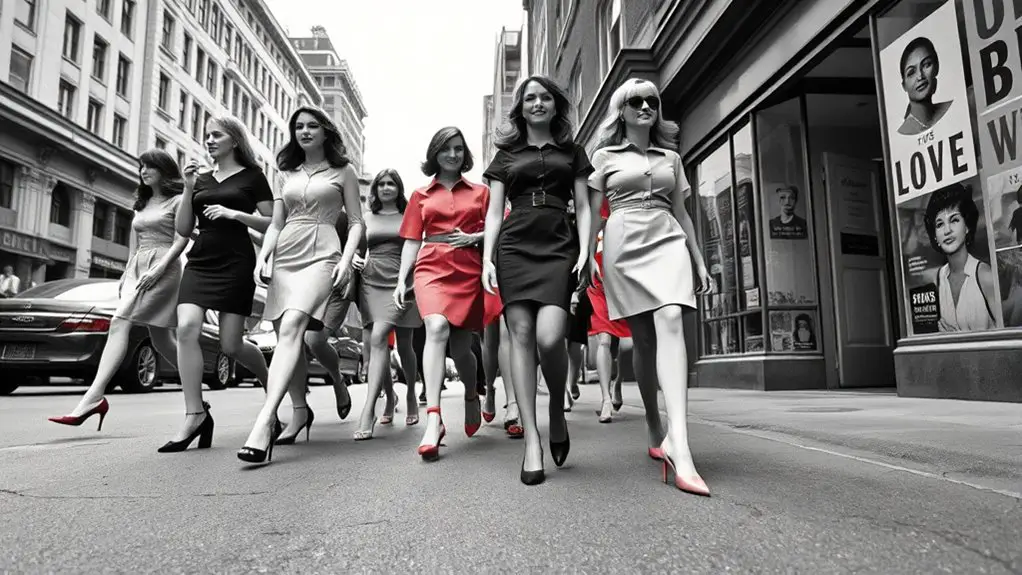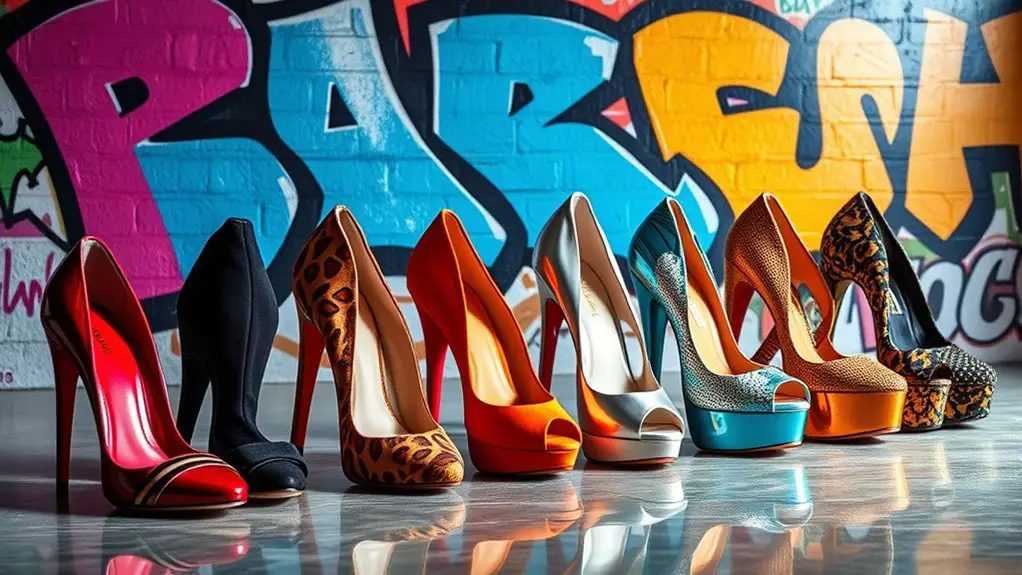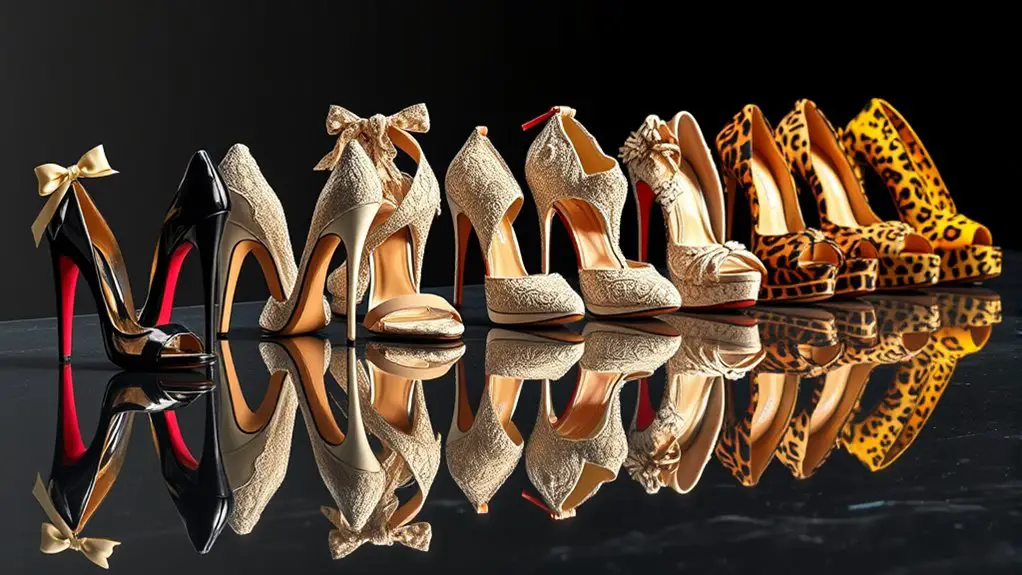High heels evolved dramatically throughout the 20th century, reflecting significant societal shifts. In the 1920s, they symbolized women’s liberation, while the glamour of Hollywood in the 1940s and 50s made them essential to elegance. During the 1960s and 70s, they became a feminist statement amidst debates on gender roles. However, by the 1980s, punk culture rejected them, promoting alternative femininity. The 1990s marked a diverse embrace of heels as personal expression. The story of heels is far more intricate.
The Rise of High Heels in the 1920s and 1930s

As the tumultuous aftermath of World War I gave way to a decade of exuberance, high heels emerged as a symbol of modernity and feminine liberation in the 1920s and 1930s. This era, marked by flapper fashion, saw women rejecting traditional roles, embracing a new sense of autonomy. High heels complemented the iconic silhouettes of the time—drop-waist dresses and bobbed hair—enhancing both stature and confidence. These elevated shoes were not merely accessories; they were statements of defiance against societal norms.
The rise of high heels coincided with changing attitudes towards femininity, where women sought to express their individuality. As you slip into a pair of these striking shoes, remember that they embody the spirit of the Roaring Twenties, a pivotal moment when fashion became a canvas for self-expression. This cultural shift set the stage for the evolving relationship between women and fashion throughout the century.
Hollywood Glamour and the Golden Age of the 1940s and 1950s
The bold experimentation of the 1920s and 1930s paved the way for a new era in fashion, where Hollywood’s influence became a defining force in the 1940s and 1950s. During this golden age, high heels evolved to embody the glamorous silhouettes that captivated audiences. Iconic actresses like:
The bold experimentation of the 1920s and 1930s set the stage for Hollywood’s glamorous influence on fashion in the 1940s and 1950s.
- Audrey Hepburn
- Marilyn Monroe
- Rita Hayworth
- Grace Kelly
- Elizabeth Taylor
used heels to enhance their stature and style, making them symbols of femininity and allure. The stiletto, in particular, emerged as a must-have accessory, accentuating curves and creating an elongated leg line. Films showcased these striking looks, establishing high heels as essential to the glamorous image of stars. The combination of fashion and cinema not only shaped public perception but also reinforced the cultural significance of high heels as tools of empowerment, elegance, and sophistication. In this era, every step taken in heels was a statement of style and confidence.
The Feminist Movement and the 1960s and 1970s

While the rise of the feminist movement in the 1960s and 1970s challenged traditional gender roles, high heels remained a complex symbol within this cultural shift. On one hand, high heels were embraced by some women as empowerment symbols, representing confidence and femininity in a world aiming for gender equality. Feminist fashion during this era often incorporated high heels, showcasing how women could assert their identity while challenging societal norms.
Conversely, many feminists critiqued high heels as instruments of patriarchy, arguing they restricted mobility and reinforced an objectified image of women. This duality reflected broader tensions within feminism itself—while some sought to reclaim femininity, others aimed to dismantle it. Hence, high heels became a battleground for feminist ideology, representing both liberation and constraint, and illustrating how fashion can embody the complexities of social change.
Punk Rock and the Edgy Styles of the 1980s
Emerging from the social upheaval of the 1960s and 1970s, punk rock in the 1980s became a powerful expression of rebellion against mainstream culture and norms, including the prevailing notions of femininity tied to high heels. The punk aesthetics embraced a raw, unpolished look that defied traditional gender norms, opting for rebellious footwear that aligned with a DIY fashion ethos.
- Combat boots and Doc Martens replaced stilettos.
- Spiked accessories and torn fabrics became symbols of defiance.
- Gender fluidity emerged, challenging the binary notions of style.
- Street style inspired a sense of community among punks.
- High heels were often rejected as symbols of oppression.
In this context, high heels transformed from symbols of femininity to objects of critique, as punk culture empowered individuals to reclaim their identity through fashion choices that prioritized comfort and authenticity over societal expectations.
The Diverse Expressions of the 1990s and Beyond

As the 1990s unfolded, a shift in cultural attitudes ignited a diverse range of fashion expressions that redefined high heels and their place in women’s wardrobes. You’d notice how high heels began to coexist with grunge aesthetics, emphasizing a rebellious spirit rather than traditional femininity. Brands like Dr. Martens offered chunky soles that catered to a more casual attitude, allowing women to break free from conventional styles.
Simultaneously, minimalist designs emerged, characterized by clean lines and understated elegance. Designers like Calvin Klein showcased sleek, simple heels that complemented the era’s obsession with functionality and comfort. In this duality, high heels transformed, reflecting both the anti-establishment ethos of grunge and the refined simplicity of minimalism. This period marked a significant evolution, where heels weren’t just about height but also about personal expression, adapting to the complexities of modern womanhood. You can see how these trends shaped today’s diverse high heel landscape.
Frequently Asked Questions
What Materials Were Commonly Used to Make High Heels Throughout the Century?
You might think high heels only use leather, but throughout the century, designers embraced various materials. Leather types, plastic innovations, and even wood were often utilized, enhancing both comfort and style in footwear fashion.
How Did High Heels Influence Women’s Fashion Trends in Different Decades?
High heels have markedly shaped women’s fashion trends, symbolizing feminine empowerment and making bold fashion statements. Each decade embraced unique styles, reflecting societal changes, where heels became essential in expressing individuality and confidence within evolving cultural contexts.
What Notable Designers Revolutionized High Heel Styles in the 20TH Century?
Notable designers like Christian Dior and Manolo Blahnik revolutionized high heel styles with their iconic designs and innovative styles. Their contributions not only shaped footwear but also influenced broader fashion trends, enhancing women’s self-expression and empowerment.
How Have High Heels Impacted Women’s Health Over the Years?
Imagine striding confidently in heels that elevate your presence, yet consider their toll on foot health. Over time, lack of ergonomic design has led to pain and discomfort, prompting a reevaluation of fashion versus well-being.
What Cultural Attitudes Towards High Heels Have Changed Over Time?
Cultural attitudes towards high heels have shifted; once symbols of femininity, they’re now often viewed through the lens of feminist movements challenging societal norms. You’ll notice increased discussions about agency and comfort versus traditional beauty standards.



